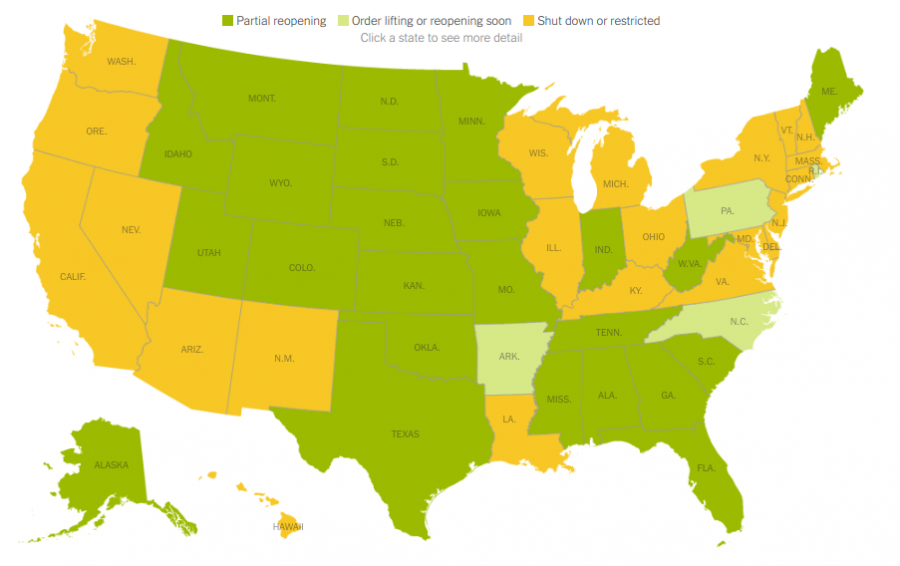States shouldn’t reopen until they have a plan
Courtesy of The New York Times
While Maryland is among the states that are still shut-down or have restrictions (gold on the map), other states like Georgia, Iowa and Montana have at least a partial reopening (dark green). Orders are lifting soon in Pennsylvania and North Carolina (pale green), even though no U. S. state has had their cases decrease for 14 days, something President Trump’s plan recommended before Governors should reopen their states.
May 11, 2020
As the number of COVID-19 cases and deaths per day starts to plateau and shrink across the country, there comes the question, “What’s next?” For millions of unemployed Americans, they hope to return to work; just like students and teachers returning to the classroom environment.
Governors now have to walk a thin-rope – open too soon, which may lead to a second wave of coronavirus or keep stay-at-home orders in effect, which may lead to angry citizens. While opening the economy may be the top priority for some governors, they should not reopen unless they have an extensive plan to make sure that there is not a second wave of this deadly disease.
Governors should listen to President Trump’s advice, at least for the most part. His ‘Opening Up America Again’ plan calls for three easy steps for governors to use. In order to begin Phase One, states need 14 days of decreasing cases and positive test percentage per day. This is a great idea; allowing governors a chance to see if cases going down is a blimp or a trend. If it is a trend, then they can begin to reopen.
However, states have not waited until the 14 days to reopen. According to an April 2020 NBC News, “no state that has opted to reopen has come close to the federally recommended decline in cases over a 14-day period.”
Then why reopen? Governors in these states, like Brian Kemp (R-Ga.), Bill Lee (R-Tenn.), Steve Bullock (D-Mont.) and Jared Polis (D-Colo.) have partially reopened their states, without the 14 days of decreasing case. Why did they reopen then? That is not part of the President’s plan.
Given the facts of the virus, reopening states may be putting people in harm’s way. People that go out to movie theaters, malls and restaurants could be getting sick or spreading the disease to others. Coronavirus can easily be spread by people being out and about. While everyone has the decision not to do these things, and stay at home, the ones that are out are harming everyone else.
Since Gov. Kemp’s decision to reopen Georgia, they have continued to have new cases. According to May 2020 AJC.com, a newspaper based in Atlanta, there were more than 1,000 new cases in Georgia in a 24-hour period after they loosened restrictions.
Also, businesses are put in a tough spot: they can open with a limited number of people in the store, which means less money or remain closed and lose money. These companies provide people with jobs and provide goods/services to the public. They should not be forced to have to make this decision, especially when they provide so much to the community.
Additionally, many of the workers do not even want to reopen. According to April 2020 The Hill, 64% of Coloradoans who lost their job or income want to keep businesses closed.
Yet, the governor partially reopened – putting people at risk of developing coronavirus. If they had a plan at least people would feel more comfortable about going out knowing it was safe to do so. The citizens in these states do not.
If states stick to the President’s plan, citizens will know that they not only worked together but have the advice of national experts in addition to their states. If more highly-knowledgeable people agree on when to reopen, it will give citizens more confidence and trust in what their state is doing.
If governors do not have a plan, and cases spike back up, they will have to close again. If the states did not have a plan to reopen, why would they have a plan to close back down again? This could lead to riots, anger and more deaths from the coronavirus.
Governors need to listen to the 14-day advice and not reopen. Once states have reached this stage, they can go to Phase One. This calls for people to return to public spaces as long as they socially-distance. It keeps schools closed and limits gathering to a maximum of ten people.
They can begin to reopen businesses and places that can provide people with the ability to socially-distance first. Parks and outdoor restaurants that keep the tables at least 6’ apart should reopen first.
If cases do not spike once again, then governors can start to reopen businesses like indoor restaurants, movie theaters, barber shops, salons and other small businesses. This way, the economy will begin to start, people will get their jobs back, patrons will feel safe and have a chance to leave their house and cases will not go back up to their old levels. Then after this, schools, theatres and other major events can start to reopen.
Some may argue that a plan to reopen is unnecessary. If the states play it by ear, they can make changes faster and will not have to worry about upsetting citizens if they do not meet their target date or change up their plans.
Having a plan will be key to citizens staying safe because it will ensure that cases do not spike, and if they do can be shut down quickly. This is essential, and no state should reopen until they have met the President’s guidelines.


